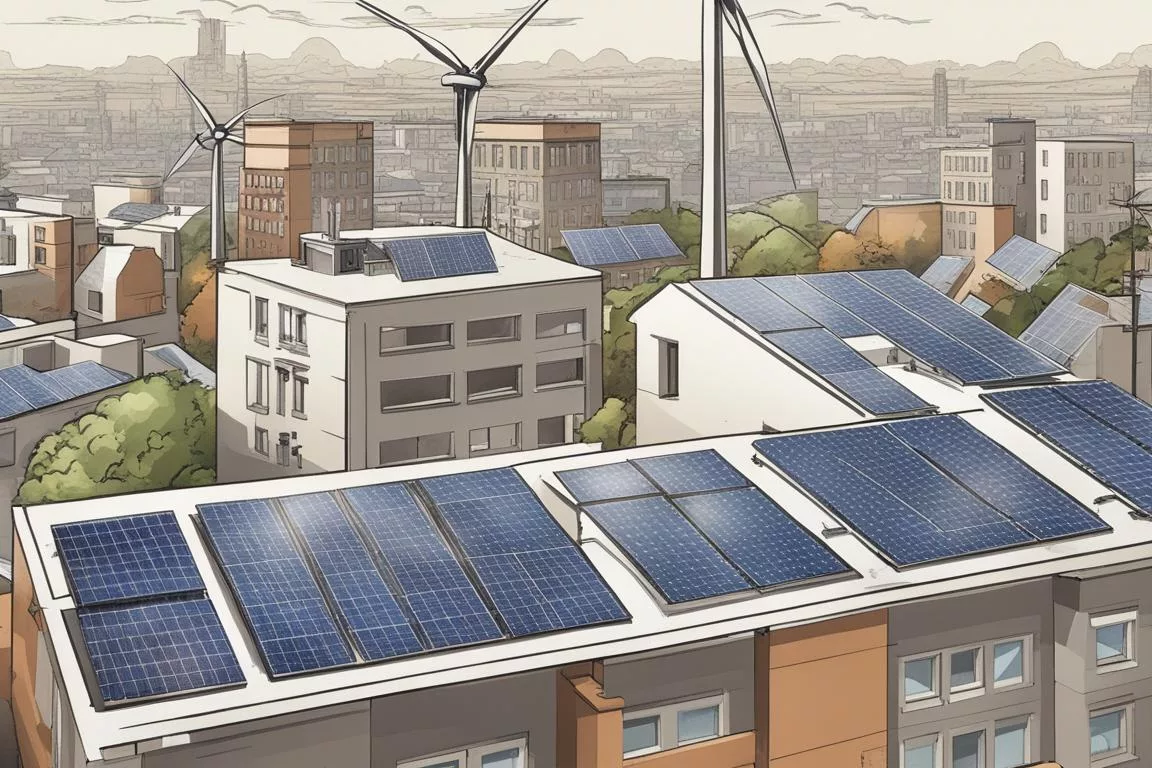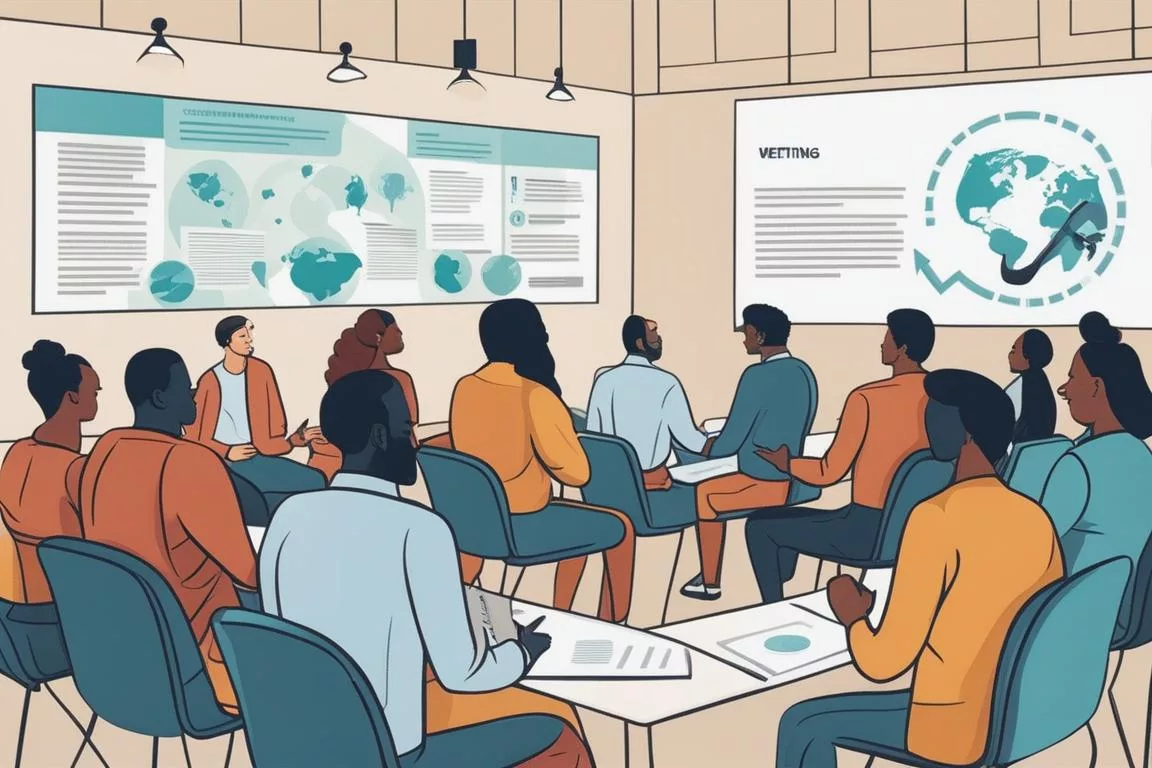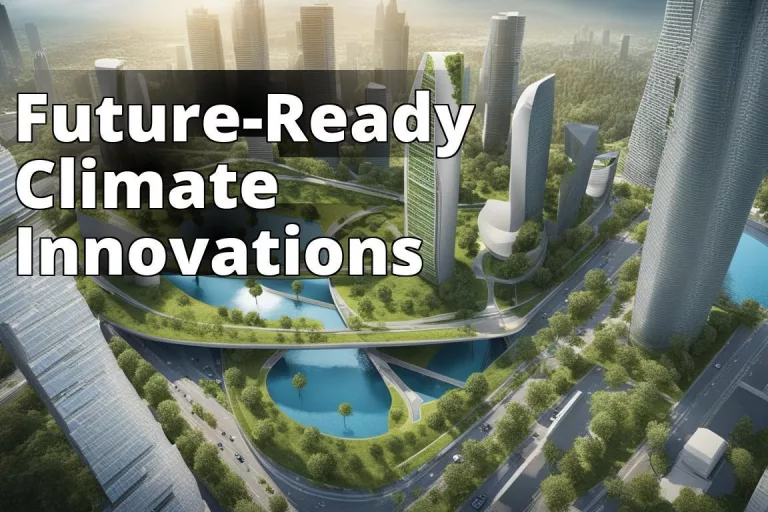Learn about Climate-Smart City Solutions
- Definition and concept of smart city solutions.
- Importance and benefits of integrating climate-smart solutions in urban development.
- Examples of successful climate-smart city projects worldwide.
As urbanization continues to accelerate, the concept of smart city solutions has garnered increasing attention. Defined as urban areas that leverage technology and data to enhance efficiency, sustainability, and quality of life, smart cities are vital in addressing contemporary challenges. In the context of climate change and urban development, the integration of smart city solutions becomes even more crucial. The focus shifts towards creating sustainable and resilient infrastructure to mitigate environmental impact and adapt to changing climate patterns.
Importance of Climate-Smart Cities
Climate-smart cities are important for several reasons. They can help tackle climate change by reducing greenhouse gas emissions in the transport sector and from electricity and heat production. Additionally, they improve the quality of life for residents through less pollution, better waste management, and more green spaces. Smart technologies enable cities to combat the effects of climate change, such as flooding and extreme heat waves, making them more responsive and efficient in mitigating climate change and its impacts. The Climate Smart Cities initiative also promotes adaptive strategies with strong co-benefits. Overall, the development of smart cities is seen as a crucial step in fighting climate change and mitigating the environmental impacts of urbanization.
Benefits of Integrating Climate-Smart Solutions
Integrating climate-smart solutions into cities offers a wide range of benefits, including:
- Environmental Sustainability: Climate-smart cities help reduce greenhouse gas emissions, combat climate change, and promote sustainable development.
- Improved Quality of Life: They lead to less pollution, better waste management, and increased green spaces, enhancing the well-being of city residents.
- Economic Growth: Integration of smart and green infrastructure can drive economic growth, increase property values, and boost tourism and labor productivity.
- Resilience to Climate Change: Smart technologies enable cities to combat the effects of climate change, such as flooding and extreme heat waves, making them more responsive and efficient in mitigating climate change and its impacts.
- Health and Well-being: Access to green spaces and smart city solutions can deliver health benefits, such as improved mental well-being and physical activity.
By embracing climate-smart solutions, cities can not only address environmental challenges but also create more sustainable, resilient, and liveable urban environments for their residents.
Examples of Climate-Smart City Projects
Some examples of climate-smart city projects include:
- Rotterdam, Netherlands: The city has created a network of green roofs acting as stormwater reservoirs to manage flooding risks.
- Mumbai, India: The Climate Smart Cities program is working to deliver an evidence-based plan for the rapid deployment of energy-efficient technologies and investment in sustainable infrastructure.
- Kingdom of Morocco: The Kingdom of Morocco has initiated an impressive Climate-Smart city initiative, focusing on sustainable urban development and resilience.
- Norfolk, Virginia, USA: The city has been using smart technologies to combat the effects of climate change, such as flooding and extreme heat waves, making it more responsive and efficient in mitigating climate change and its impacts.
These projects demonstrate the diverse ways in which cities around the world are integrating climate-smart solutions to address environmental challenges and create more sustainable and resilient urban environments.

Technologies for Climate-Resilient Cities
Technologies for climate-resilient cities include:
- Sensors: Used to monitor local impacts of climate change, such as temperature, humidity, and air quality.
- Satellite earth observation: monitor local conditions from space.
- Renewable Energy Generation and Storage: Provides resilience to climate shocks and reduces dependence on traditional energy sources.
- Information and Communication Technology (ICT): Enables decentralized and resilient communication networks, crucial during climate-related emergencies.
- Internet of Things (IoT): Facilitates data-driven decisions to save energy, water, and reduce CO2 emissions through smart environmental sensors.
- Green Roofs: Act as stormwater reservoirs to manage flooding risks.
- Smart Transportation Systems: Help cities address the impact of climate change by integrating and processing real-time data to mitigate traffic congestion and reduce emissions.
- Adaptive Infrastructure: Such as sea walls and storm drain networks, to address the impact of climate change on cities, particularly in low-lying areas.
- Smart Environmental Sensors: Efficiently monitor parameters such as temperature, humidity, solar irradiance, and air quality.
- Decentralized Communication Networks: Crucial during climate-related emergencies, ensuring continued access to vital information and services.
- Real-time Data Analytics: Enable cities to make informed decisions to avert or mitigate the impact of climate-related events.
These technologies play a crucial role in building climate-resilient cities by enabling them to monitor, adapt to, and mitigate the impacts of climate change.

Innovations in Urban Planning and Design
Innovations in urban planning and design related to climate-smart cities include:
- Smart Technologies Integration: Smart cities leverage ICTs to enhance the quality and performance of urban services like utilities and governance, leading to reduced resource consumption, decreased waste, and improved quality of life.
- Green Infrastructure: The integration of green infrastructure, such as green roofs, helps manage flooding risks and promotes environmental sustainability.
- Real-time Data Analytics: Cities use real-time data from people, devices, and infrastructure to enhance sustainable resource usage, city services, and overall liveability.
- Renewable Energy Generation and Storage: The rapid deployment of energy-efficient technologies and investment in sustainable infrastructure promotes resilience to climate change and reduces dependence on traditional energy sources.
- Adaptive Urban Environments: Urban planning aims to create adaptable environments that shield against the worst impacts of climate change, addressing concerns such as environmental sustainability, equity, affordability, and public health.
These innovations demonstrate how urban planning and design are being transformed to create more sustainable, resilient, and liveable cities in the face of climate change.
Role of Data in Climate-Smart Cities
The roles of data in climate-smart cities are multifaceted and crucial for building resilience and mitigating the impacts of climate change. Here are some key roles of data in climate-smart cities:
- Real-time Monitoring: Data from smart environmental sensors and IoT devices enable cities to monitor parameters such as temperature, humidity, air quality, and more in real time, allowing for proactive decision-making to address climate-related events.
- Data-Driven Decisions: Cities use data analytics to make informed decisions to avert or mitigate the impact of climate-related events, such as flooding and extreme heat waves.
- Open Data Systems: Open data solutions enable clear digital communication channels between the city and its citizens, fostering citizen engagement and participatory mapping and budgeting, which are essential for building climate-resilient smart cities.
- Empowering Climate Resilience: Data empowers smart cities to maintain climate resilience by constantly gathering and analyzing data from urban environments, identifying and addressing urgent climate issues, and making structural changes in citizen engagement processes.
Related article: Navigating Privacy Risks of Crowdsourced Environmental Data
Financing Climate-Smart Cities
As the threats of climate change grow more severe, cities around the world are seeking innovative ways to reduce emissions and build resiliency against future impacts. Many cities are embracing the “climate-smart city” model – integrating climate change mitigation and adaptation into urban planning and operations. However, transitioning to climate-smart infrastructure requires major upfront investments that strain city budgets. Creative financing solutions are essential to overcoming this barrier.
Public-Private Partnerships
Public-private partnerships (PPPs) allow governments to contract with private companies to design, build, and finance projects. With PPPs, the private entity provides capital to cover the initial costs in exchange for operating the infrastructure over an extended concession period. This transfers much of the financial risk from taxpayers onto private balance sheets. PPPs have been used extensively to build climate-smart infrastructure like public transit systems, district energy plants, and resilient power grids. By ensuring future revenue streams, PPPs can leverage private capital to accelerate the deployment of transformative climate projects cities would struggle to fund on their own.
Green Bonds
Issuing municipal green bonds is another method cities are using to raise low-cost financing for climate adaptation and emissions reduction programs. The “green” label signals to investors that the funds will specifically support environmentally-beneficial projects. This branding allows cities to expand their investor base to include sustainability-focused funds. It also enables cities to potentially borrow at lower interest rates. In 2020 alone, cities issued over $45 billion in green bonds to mitigate climate impacts. Streamlining and standardizing green bond reporting requirements could bolster investor confidence and drive further growth in this climate-aligned asset class.
Climate Funds & Subsidies
A myriad of global climate funds have formed over the past decade to help cities in developing countries leapfrog to sustainable infrastructure systems. These include multi-lateral funds like the Green Climate Fund and the Climate Investment Funds. Significant funding is also flowing from national governments – the United States’ Inflation Reduction Act and India’s Smart Cities Mission being just two examples. Grant funding and subsidies can catalyze climate-smart city transitions in lower-income regions that have more difficulty raising their own financing for large capital projects. Wealthy nations should make meeting their collective $100 billion per year climate finance commitment a top priority if equitable climate-smart city proliferation is the end goal.
Policy and Governance for Climate-Smart Cities
Urban policymakers hold the power to pave the way for transformative climate progress within their jurisdictions. To steer cities toward low-carbon, climate-resilient trajectories, leaders across municipal government must coordinate to dismantle barriers and actively facilitate sustainable development. Strategic policies, structured governance models, and public-private collaboration can drive the systems-level changes needed for cities to embrace the climate-smart model.
Amending Zoning and Building Codes
Outdated zoning and building codes often unintentionally obstruct climate-smart urban growth. Municipal governments should conduct full reviews of their codes and amend where necessary to enable climate-aligned projects. Changes could include relaxing zoning to allow higher density, mixed-use development, reducing parking minimums to discourage automobile dependency, approving distributed renewable installations, and requiring all new constructions meet stringent energy efficiency and electrification benchmarks. Policy signals must clearly direct real estate developers to deliver sustainable buildings and infrastructure.
Streamlining Procurement Processes
Municipal governments also steer climate action through their sizable procurement budgets. Cities should streamline and standardize procurement policies to incentivize purchases of energy efficient products and clean technologies. Preferential purchasing of low-carbon goods and services amplifies market demand, scales sustainable industries, and nurtures local green jobs.
Developing Institutional Capacity
Realizing bold city climate plans requires building bureaucracies specially equipped to execute strategy. To institutionalize climate governance, cities should either establish new chief climate officer positions or dedicate full departments to oversee mitigation and adaptation initiatives across municipal operations. Further integrating climate planning with economic development, infrastructure management, budgeting, and health and social services is also critical for managing complex interdependencies. Investing in dedicated staff and governance systems brings structure and accountability to city climate programs.
Enabling Public-Private Collaborations
The scale of urban climate challenges far exceeds the capacity of local governments alone. Public-private partnerships allow cities to leverage business resources and expertise while businesses earn brand value by demonstrating climate leadership. Policies should facilitate sharing costs, risks, and rewards between public agencies and private entities on projects like building microgrids, deploying electric vehicle fleets, creating resilience hubs, and much more. Cities not only need comprehensive climate plans – they need binding governance frameworks that mobilize, coordinate, and maximize contributions from all partners.

Community Engagement and Equity
Cities pursuing the climate-smart model must put historically excluded and vulnerable communities at the center of planning processes to ensure equitable outcomes. Top-down, technocratic approaches to urban sustainability often fail to meet the needs of marginalized groups and reinforce environmental injustice. Avoiding this requires deliberately creating policies, programs, and projects to empower and uplift communities that climate change disproportionately burdens.
Read more: Technologies to Optimize Climate Change Communication
Inclusive Community Engagement
Robust community engagement enables cities to craft climate solutions directly informed by what residents actually want and need. Cities should actively seek participation from low-income communities, communities of color, immigrants, disabled populations and other groups typically excluded from political and civic life when formulating mitigation and adaptation plans. Engagement initiatives like surveys, neighborhood meetings, participatory budgeting and design processes, and advisory committees allow these groups to vocalize priorities and concerns. Their invaluable lived experience shines light on climate vulnerabilities requiring urgent attention and pathways for building equitable resilience.
Co-Creating Community-Led Plans
Truly equitable climate action requires devolving decision-making power to community members themselves. Cities should provide historically marginalized communities organizational support and resources to autonomously develop bottom-up climate preparedness plans tailored to their circumstances. Uplifting community-generated strategies that draw on groups’ existing strengths and networks builds agency over the climate response and empowers community self-determination.
Funding Community-Serving Projects
Cities also need targeted mechanisms to route climate dollars directly into underserved neighborhoods. Municipal grant programs can fund community-led resilience hubs, distributed clean energy projects, green workforce training programs, cooling centers, emergency preparation and response systems, and more. Preferential community access to sustainability funding via set-asides or scoring criteria in Requests for Proposals additionally elevates community-serving climate projects.
Prioritizing justice, equity and truly inclusive engagement provides a blueprint for climate action responsive to communities’ self-identified needs, not presumed needs. When historically excluded voices direct the vision and participate as equal partners, the resulting urban climate transition can transcend technocratic notions of “smart cities” to foster climate justice and community wellbeing.
Related article: Environmental Data and Indigenous Data Sovereignty

Challenges
Some barriers to implementing climate-smart solutions for climate-smart cities include:
- Regulatory and Budgetary Constraints: The implementation of climate-smart infrastructure is often hindered by regulatory and budgetary constraints. These constraints can limit the ability of cities to invest in innovative technologies and sustainable infrastructure.
- Upfront Investment and Financing: The substantial upfront investment required for smart technologies and climate-smart solutions can be a significant barrier. Innovative financing models and public-private partnerships are essential to overcome this challenge.
- Privacy Concerns and Cybersecurity Risks: The integration of information and communication technologies (ICT) in smart cities raises concerns about privacy and cybersecurity risks. Addressing these concerns is crucial to ensure the successful implementation of climate-smart solutions.
- Digital Divide: The digital divide, which refers to the gap between those who have access to digital technologies and those who do not, can hinder the equitable deployment of climate-smart solutions. Bridging this divide is essential to ensure that all communities benefit from these innovations.
- Fiscal Limitations: The fiscal limitations of local governments can pose a barrier to the deployment of climate-smart solutions. Overcoming these limitations requires innovative financing mechanisms and a shift in investment towards sustainable infrastructure.
Future Outlook
Advancements in Technology and Policy
The future of climate-smart cities is poised for significant advancements in technology and policy, with innovations in areas such as nanotechnology, environmental big data, and AI set to revolutionize the landscape of sustainable urban development.
Related article: Top 10 Cutting-Edge Technologies Transforming the Field of Science
Prospects for Climate-Smart Cities
The prospects for climate-smart cities are promising, with growing momentum towards sustainable urbanization and environmental conservation, as witnessed in cities worldwide.
Anticipated Impact on Urban Development and Environmental Conservation
The anticipated impact of climate-smart cities on urban development and environmental conservation is profound, as cities worldwide embrace sustainable practices and leverage innovative technologies.
Frequently Asked Questions
Q. What are smart city solutions for climate change?
A. Smart city solutions for climate change include sustainable energy, smart transportation, and efficient waste management.
Q. Who develops smart city solutions for climate change?
A. Technology companies, urban planners, and environmental experts collaborate to develop smart city solutions for climate change.
Q. How do smart city solutions address climate change?
A. Smart city solutions address climate change by reducing carbon emissions, improving energy efficiency, and promoting sustainable practices.
Q. What if traditional infrastructure is already in place?
A. Even with traditional infrastructure, smart city solutions can be integrated gradually to improve sustainability and resilience to climate change.
Q. How can smart city solutions benefit communities?
A. Smart city solutions can benefit communities by improving air quality, reducing traffic congestion, and creating more energy-efficient homes and buildings.
Q. What are the objections to implementing smart city solutions?
A. Some objections include concerns about the initial cost, potential privacy issues, and the need for public education about the benefits of smart city solutions.
Next Steps
Round Table Environmental Informatics (RTEI) is a consulting firm that helps our clients to leverage digital technologies for environmental analytics. We offer free consultations to discuss how we at RTEI can help you.


